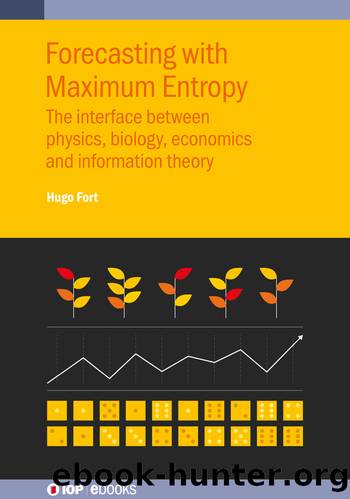Forecasting with Maximum Entropy: The interface between physics, biology, economics and information theory by Hugo Fort

Author:Hugo Fort
Language: eng
Format: epub
ISBN: 9780750339315
Publisher: IOP Publishing
Published: 2022-11-21T00:00:00+00:00
Similarly, for discrete time, we have that an equilibrium n*, by definition, must verify:
(A.2â²)
community matrix is the Jacobian matrix, given by:
(A.3)
and then, by equation (A.2), we can simply write the community or Jacobian matrix Jij as:
(A.4)
However, the problem with this method is that it can only establish local stability or instability. On the other hand, ecosystems in the real world are subject to large perturbations of the initial state, and continual disturbances on the system dynamics that may produce important departures from equilibrium. Since the equations of population biology are nonlinear, their solutions, which can be represented as an S-dimensional surface, can give rise to quite complicated âlandscapesâ. And therefore neighborhood stability analysis may give a misleading representation of the full global stability of the system.
If the dynamical equations are linear, local and global stability are identical. Unfortunately, while the linear approximation is very useful to approach many problems in physics, it rarely is a sensible approach in population biology. However, many biologically interesting models, although nonlinear, produce relatively simple landscapes, with one valley or hilltop whose sides slope ever upward or downward, respectively. In this case the local stability analysis correctly describes the global stability. Such circumstances are characterized by the existence of a Lyapunov function and constitute the basis of a powerful analytical method for establishing that an equilibrium is globally stable, i.e., stable relative to finite perturbations of the initial state. The so-called direct or second method of Lyapunov (LaSalle and Lefschetz 1961, Gurel and Lapidus, 1968, Willems, 1970, Strogatz 1994). There are many methods for constructing Lyapunov functions (Schultz 1965, Gurel and Lapidus 1968, Burton 1969, Hafstein 2007). However, unfortunately, there is no general way of knowing whether a Lyapunov function exists, let alone a straightforward procedure to construct it if it does exist.
In any event, for a given model it is possible to use computer simulations to investigate the behavior of the model for finite perturbations of its initial state. But computer simulations cannot guarantee that an equilibrium does indeed have a finite region of attraction. Certainly, this procedure becomes increasingly worse as the number of species in a given community increases.
In the next section of this appendix we will consider the local stability for two-dimensional systems. In the third and final section we will return to local and global stability, review the two methods outlined above, the one based on the eigenvalues of the Jacobian matrix and Lyapunovâs method.
Download
This site does not store any files on its server. We only index and link to content provided by other sites. Please contact the content providers to delete copyright contents if any and email us, we'll remove relevant links or contents immediately.
The Complete Stick Figure Physics Tutorials by Allen Sarah(6650)
Secrets of Antigravity Propulsion: Tesla, UFOs, and Classified Aerospace Technology by Ph.D. Paul A. Laviolette(3580)
Thing Explainer by Randall Munroe(3337)
The River of Consciousness by Oliver Sacks(2999)
The Order of Time by Carlo Rovelli(2730)
I Live in the Future & Here's How It Works by Nick Bilton(2534)
How To by Randall Munroe(2494)
A Brief History of Time by Stephen Hawking(2482)
The Great Unknown by Marcus du Sautoy(2195)
What If?: Serious Scientific Answers to Absurd Hypothetical Questions by Randall Munroe(2178)
Blockchain: Ultimate Step By Step Guide To Understanding Blockchain Technology, Bitcoin Creation, and the future of Money (Novice to Expert) by Keizer Söze(2143)
Midnight in Chernobyl by Adam Higginbotham(2084)
Networks: An Introduction by Newman Mark(2002)
The Meaning of it All by Richard Feynman(1915)
Easy Electronics by Charles Platt(1870)
The Tao of Physics by Fritjof Capra(1858)
When by Daniel H Pink(1781)
Midnight in Chernobyl: The Untold Story of the World's Greatest Nuclear Disaster by Adam Higginbotham(1777)
Introducing Relativity by Bruce Bassett(1758)
